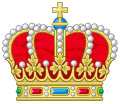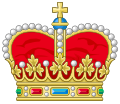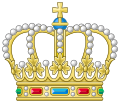Coronet

In British heraldry, acoronetis anycrownwhose bearer is less than sovereign or royal in rank, irrespective of the crown's appearance. In other languages, this distinction is not made, and usually the same word forcrownis used irrespective of rank (German:Krone,Dutch:Kroon,Swedish:Krona,French:Couronne,Italian:Corona,etc.) In this use, the Englishcoronetis a purely technical term for all heraldic images of crowns not used by a sovereign, and implies nothing about the actual shape of the crown depicted. A Coronet is another type of crown, but is reserved for the lower ranks of nobility like Marquesses and Marchionesses, Earls and Countesses, Barons and Baronesses, and some Lords and Ladies. The specific design and attributes of the crown or coronet signifies the hierarchy and ranking of its owner.
Certain physical coronets are worn by the British peerage on rare ceremonial occasions, such as the coronation of the monarch. These are also sometimes depicted in heraldry, and calledcoronets of rankin heraldic usage. Their shape varies depending on the wearer's rank in the peerage, according to models laid down in the 16th century. Similar depictions of crowns of rank (German:Rangkronen) are used in continental heraldry, but physical headgear has never been made to imitate them.
Due to the extreme rarity of occasions in which peers' coronets are worn (sometimes more than fifty years pass before a new coronation and occasion to wear physical coronets), practical use of the termcoronettoday is almost exclusively confined to pictorial crowns andrank symbolsinheraldry,adorning someone'scoat of arms(indeed, many people entitled to a coronet never have a physical one made). Depiction of ordinary crowns or coronets in heraldry, rather than coronets of rank, including a variety ofcrest coronetssometimes placed under thecrest,are not confined to peers, and are often shown in British heraldry outside the peerage.
| Part of aserieson |
| Heraldicachievement |
|---|
| External devices in addition to the centralcoat of arms |
|
|
Etymology[edit]
The word stems from theOld Frenchcoronete,a diminutive ofco(u)ronne('crown'), itself from theLatin:corona,lit. 'crown, wreath' and from theAncient Greek:κορώνη,romanized:korōnē,lit. 'garland, wreath'.
Traditionally, such headgear is used bynoblesand byprincesandprincessesin theircoats of arms,rather than bymonarchs,for whom the word 'crown' is customarily reserved inEnglish,while many languages have no such terminological distinction. As a coronet shows the rank of the respective noble, in theGermanandScandinavianlanguages there is also the termrangkrone(literally 'rank crown').
Commonwealth usage[edit]

Traditionally, in theUnited Kingdom,apeerwears the coronet on one occasion only: for aroyal coronation,when it is worn along withcoronation robes,equally standardised as a luxurious uniform. However, for the 2023 coronation ofKing Charles III,on the government's advice, the King forbade the wearing of coronets by those peers who had been invited, except those performing specific ceremonial roles.[1]
In thepeerages of the United Kingdom,the design of a coronet shows the rank of its owner, as in German, French and various other heraldic traditions. Dukes were the first individuals authorised to wear coronets. Marquesses acquired coronets in the 15th century, earls in the 16th and viscounts and barons in the 17th. Until the barons received coronets in 1661, the coronets of earls, marquesses and dukes wereengravedwhile those of viscounts were plain. After 1661, however, viscomital coronets became engraved, while baronial coronets were plain. Coronets may not bear any precious or semi-precious stones.[2]
Since a person entitled to wear a coronet customarily displays it in theircoat of armsabove theshieldand below thehelmetandcrest,this can provide a useful clue as to the owner of a given coat of arms. InCanadian heraldry,descendants of theUnited Empire Loyalistsare entitled to use a Loyalist military coronet (for descendants of members of Loyalist regiments) or Loyalist civil coronet (for others) in their arms.
Royal usage[edit]

Members of theBritish royal familyoften have coronets on their coats of arms, and may wear actual coronets at coronations (e.g., PrincessesElizabethandMargaretat the1937 coronation of their fatherasGeorge VI). They were made according to regulations instituted byKing Charles IIin 1661, shortly after his return from exile in France (getting a taste for its lavish court style;Louis XIVstarted monumental work atVersaillesthat year) duringthe Restoration.They vary depending on the prince's relationship to the monarch. Occasionally, additional royal warrants vary the designs for individuals. The most recent (and most comprehensive) royal warrant concerning coronets was the 19 November 1917 warrant ofGeorge V.[5]
The coronet of theheir apparentis distinctive in itself as it has a single arch with a globe and cross.
Charles IIIabolished the use of coronets at hiscoronation in 2023for both members of the Royal Family and peers.
| Image | Details |
|---|---|
| Princes and Princesses | |

|
Child of a sovereign
A coronet of crosses and fleurs-de-lis. |

|
Child of an heir apparent
A coronet of crosses, strawberry leaves and fleurs-de-lis. |

|
Child of a son of a sovereign
A coronet of crosses and strawberry leaves. |

|
Child of a daughter of a sovereign[2]
A coronet of strawberry leaves and fleurs-de-lis. |
| (Non-royal) Peers and Peeresses | |

|
DukeorDuchess
A silver-gilt circlet, chased as jewelled but not actually gemmed, with eight strawberry leaves of which five are seen in two-dimensional representations. |

|
MarquessorMarchioness
A coronet of four strawberry leaves and four silver balls (known as "pearls", but not actually pearls), slightly raised on points above the rim, of which three leaves and two balls are seen. |

|
EarlorCountess
A coronet of eight strawberry leaves (four visible) and eight "pearls" raised on stalks, of which five are visible. |

|
ViscountorViscountess
A coronet of sixteen "pearls" touching one another, nine being seen in representation. |

|
BaronorBaroness,LordorLady of Parliament
A plain silver-gilt circlet, with six "pearls" of which four are visible. |
-
EnglishKing of Arms
-
Loyalistsmilitary coronet (Canadian)
-
Loyalists civil coronet (Canadian)
Municipal usage[edit]
Certain types of local government have special coronet types assigned to them.
| Image | Details |
|---|---|

|
Coronet of aScottish Regional Council(1973–1996)
A circlet richly chased from which are issuant four thistles leaved (one and two halves visible) Or.[6] |
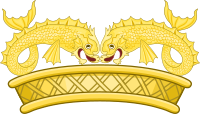
|
Coronet of aScottish Island Council(1973–1996)
A circlet richly chased from which are issuant four dolphins two and two respectant naiant embowed (two visible) Or.[7] |

|
Coronet of aScottish District Council(1973–1996)
A circlet richly chased from which are issuant eight thistle heads (of which three and two halves are visible) Or.[8] |

|
Coronet of aScottish Community Council(1973–present)
A circlet richly chased from which are issuant four thistle leaves (one and two halves visible) and four pine cones (two visible).[9] |
Danish coronet rankings[edit]
-
Crown of Nobility
Spanish coronet rankings[edit]
All over the world, Spanish heraldry has used these crowns and coronets:
-
Infante or Infanta
(Variant for the Spanish territories of the formerCrown of Aragon) -
Marquess
-
Count
-
Lord(señor)
-
Hidalgo(Spanish nobleman)
-
SpanishOfficer of Arms(Herald and Pursuivant / Persevante)
Swedish coronet rankings[edit]

-
Heir Apparent
-
Crown of Nobility
Former monarchies[edit]
Kingdom of France[edit]
The hierarchy among theFrench nobility,which was identical for non-royal titles to the British hierarchy of peers, should not be understood to be as rigid in the ranking of titleholders as the latter. In particular, a title was not a good indication of actual preeminence or precedence: ancestry, marriages, high office, military rank and the family's historical renown counted far more than the precise title. Some distinguished families held a title no higher than count or even baron, but were proud of their ancient origin. Moreover, most of the nobility was legally untitled. Some hereditary titles could be acquired by a nobleman who purchased a "titled"fief,whiletitres de courtoisie('courtesy titles') were freely assumed in the absence of strict regulation by the French crown and became more numerous than titles legally borne. In the 17th and 18th centuries, people assumed and used freely coronets of ranks that they did not have; and, in the 19th and 20th centuries abuse was still made of 'courtesy titles'. Titles continued to be granted until theSecond Empirefell in 1870, and legally survive among their descendants.
The only title that was never usurped under theancien régime,and rarely without some excuse afterwards, was the title ofduc– because it was so often attached to the rank ofpeer of France,which carried specific legal prerogatives, such as the right to a seat in theParlement of Paris.As a result, the title ofducwas actually, as well as nominally, at the top of the scale after the royal family and foreign princes, and a cut above all of the other nobility. During theancien régime,'prince' was a rank, not a title, hence there was no coronet.
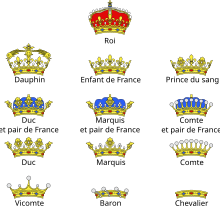
- Roi(sovereign): closed crown offleurs-de-lis(the crown was open until the early 16th century)
- Dauphin(heir apparent): initially an open crown of fleurs-de-lis; starting withHenri IV's son (1601–10), the crown is closed with dolphins instead of arches
- Fils de FranceandPetit-fils de France(sons and grandsons of a sovereign): open coronet of fleurs-de-lis
- Prince du sang(male-line descendants of a grandson of the sovereign): originally an open coronet alternating fleurs-de-lis andacanthusleaves (called strawberry leaves in English blazon), but the open coronet of fleurs-de-lis was used in the 17th and 18th centuries
- Pair de France(peer of the realm): coronet of the title (usually duke) with a blue velvetbonnet,along with a mantlearmoyé(reproducing the arms) fringed with gold and lined withermine
- Duc(duke): coronet of acanthus leaves
- Marquis(marquess): coronet of alternating acanthus leaves and groups of three pearls in trefoil (or two pearls side by side in some versions)
- Comte(count): coronet of pearls
- Vicomte(viscount): coronet of four large pearls (three visible) alternating with smaller pearls
- Vidame(peculiar French title, for protectors of the temporal estates of abishopric): coronet of four crosses (three visible)
- Baron:helm of gold wreathed with a string of small pearls
- Chevalier(knight): helm of gold
- Ecuyer(squire): helm
Holy Roman Empire[edit]
TheHoly Roman Empire,and consequently its successor states (Austria, Germany and others), had a system very similar to that of the British, although the design varied.
- Herzogskrone:the coronet of aHerzog(duke) displays five visible leaves, with a crimson bonnet on top, surmounted by five visible arches and aglobus cruciger.
- Fürstenkrone:the coronet of aFürst(ruling prince) shows five visible leaves, with a crimson bonnet on top, surmounted by three visible arches and aglobus cruciger.
- Landgrafenkrone:the coronet of aLandgraf(landgrave) shows five visible leaves, surmounted by three visible arches and aglobus cruciger.
- Grafenkrone:the coronet of aGraf(count) displays nine visible tines with pearls. Some of the senior comital houses used coronets showing five leaves and four pearls (some mediatized counties and minor principalities had other types of coronets that distinguished them from regular counts).
- Freiherrnkrone:the coronet of aFreiherr(baron) shows seven visible tines with pearls.
- Adelskrone:the coronet ofAdelmembers (untitled nobility) displays five visible tines with pearls. Sometimes, the central and outer tines are leaves and the other tines are headed by pearls. In the southern states ofBavariaandWürttemberg,usually all tines are headed by pearls.
-
Herzogskrone
-
Fürstenkrone
-
Landgrafenkrone
-
Grafenkrone
-
Freiherrnkrone
-
Adelskrone
Considering the religious nature of theHoly Roman Empire,one can say that, except for the short-lived Napoleonic states, no continental secular system of heraldry historically was so neatly regulated as under the British crown. Still, there are often traditions (often connected to the Holy Roman Empire,e.g.,those in Sweden, Denmark or Russia) that include the use of crown and coronets. While most languages do not have a specific term for coronets, but simply use the word meaningcrown,it is possible to determine which of those crowns are for peerage or lower-level use, and thus can by analogy be called coronets.
Precisely because there are many traditions and more variation within some of these, there is a plethora of continental coronet types. Indeed, there are also some coronets for positions that do not exist or entitle one to a coronet in theCommonwealthtradition. Such a case in French (ancien,i.e.,royal era) heraldry, where coronets of rank did not come into use before the 16th century, is thevidame,whosecoronet (illustrated)is a metal circle mounted with three visible crosses (there is no documentary or archeological evidence that such a coronet was ever made).
Often, coronets are substituted byhelmets,or only worn on a helmet.
Austria-Hungary[edit]
Although these crowns/coronets were usually granted with arms, sometimes the coronet was not granted.
Kingdom of Portugal[edit]
These coronets and crowns were used in Portuguese heraldry:
-
RoyalCrown of Portugal
-
Prince Royal(Heir Apparent)
-
Prince of Beira
(Heir Apparent's eldest son) -
Infante(Prince)
See also[edit]
References[edit]
- ^Rayner, Gordon; McTaggart, Ian (14 April 2023)."Coronation row over hundreds of peers forbidden from wearing robes".The Telegraph.Retrieved16 April2023.
- ^abCox, Noel (1999)."The Coronets of Members of the Royal Family and of the Peerage".The Double Tressure, the Journal of The Heraldry Society of Scotland.No. 22. pp. 8–13. Archived fromthe originalon 15 April 2006.Retrieved19 October2007.
- ^Ciara.Berry (15 January 2016)."Honours of the Principality of Wales".The Royal Family.Retrieved18 November2022.
- ^"Titles and Heraldry: Prince of Wales".www.princeofwales.gov.uk.Retrieved18 November2022.
- ^1917 royal warrant
- ^"Practical Heraldry for the Self-Isolator (5A)"(PDF).Court of the Lord Lyon.Retrieved14 October2020.
- ^"Practical Heraldry for the Self-Isolator (5B)"(PDF).Court of the Lord Lyon.Retrieved14 October2020.
- ^"Practical Heraldry for the Self-Isolator (5B)"(PDF).Court of the Lord Lyon.Retrieved14 October2020.
- ^"Practical Heraldry for the Self-Isolator (9A)"(PDF).Court of the Lord Lyon.Retrieved14 October2020.
Sources and external links[edit]
- The Coronets of Members of the Royal Family and of the Peerage
- Heraldica.org French heraldry
- Illustration of the coat of arms of the Duke of Norfolk, showing the design of coronet
- Illustration of the coat of arms of the Earl of Annandale and Hartfell, showing the design of coronet
- The Crowns, Coronets and Crests of the Ladies and Knights of the Garter






































